The Ghoul of the Olive Groves
Reading Time: 13 min
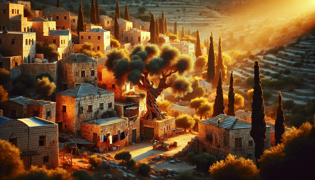
About Story: The Ghoul is a from palestinian set in the . This tale explores themes of and is suitable for . It offers insights. A brave boy faces his village's fears, prompting discussion about bias.
Introduction
In the heart of a sprawling Palestinian village, where ancient olive trees whispered secrets to the wind and golden rays of sunlight danced playfully on weathered stone walls, life ambled along a well-worn path of tradition and subtle unease. The village, nestled in a valley caressed by the gentle warmth of the Mediterranean sun, had long succumbed to stories of a spectral ghoul that roamed the outskirts. Elders recalled fragmented accounts passed down through the generations, mixing fact with fable in the soft murmur of twilight gatherings. Against this melodic backdrop lived Khalil, a gentle yet resolute boy with eyes as deep and mysterious as the valley itself. From a tender age, Khalil’s curiosity stretched beyond the simple truths of everyday life. While many of his peers recoiled in timid respect of the ghostly legend, he was captivated by a stubborn spark of wonder—a yearning to understand the blurred line between myth and reality.
The air carried scents of jasmine and freshly baked flatbread as the villagers busied themselves, yet an undercurrent of anxiety simmered beneath their daily routines. Then there were the gentle voices of his family; his mother’s warm embrace and his father’s deep, comforting tones spoke of virtues like honor and perseverance, yet even they could not help but tremble when speaking of the haunting presence beyond the ancient groves. In these moments, Khalil recognized not only fear, but a lingering bias—a barrier between understanding and superstition. Determined to uncover the truth and shed light on dark corners of distrust, Khalil resolved that the ghoul, whichever form it took, would no longer be a symbol of communal dread but a key to unlocking long-held prejudices. His heart brimmed with a tender mix of hope and courage, setting him unknowingly upon the path of transformation. As the sun climbed high, painting the earth in strokes of vibrant amber and green, the stage was set for a journey that would deeply weave together the threads of myth, bravery, and the slow, stirring call for change.
Whispers of the Night
As twilight descended upon the village, the spoken words of its people turned to whispers and soft gasps, recounting eerie encounters in the outskirts. In hushed conversations beneath the fluttering shadows of date palms, elders narrated the legends of the ghoul—a spectral figure said to wander where light seldom touched. Khalil sat rapt among his family one cooling evening, his eyes fixed on a flickering oil lamp as his grandfather’s voice trembled with both sorrow and wonder. Tales spun of a creature with a heart of darkness that mimicked lost souls and punished the arrogant. Doubtless, these stories were steeped in centuries-old fear, a potent mixture of superstition and collective memory. Yet for Khalil, each word was a spark of curiosity rather than a seed of terror.
In the lingering glow of dusk, the village’s narrow lanes and modest stone dwellings seemed to absorb every intonation of these age-old narrations. The landscape, bathed in the somber light of the setting sun, became a mosaic of shifting colors—deep blues intermingled with the fading warmth of day. Behind every doorway and beneath every gnarled olive branch, the possibility of an encounter with the ghoul nagged at the minds of the villagers, even as unspoken biases often dictated their reactions. They preferred caution to investigation, tradition to challenge.
In the heart of the gathering, Khalil's inquisitive nature could not be quelled. As he listened to an elderly neighbor describe the ghoul's eerie silhouette and haunting cry, he began to wonder if the creature was as malevolent as the story suggested, or perhaps a misunderstood shadow of a more complex truth. The villagers, conditioned by fear, had allowed this legend to foster a barrier—an invisible yet potent bias against the unknown.
That night, beneath a starlit sky marked by soft constellations, Khalil walked home slowly, the path lined with olive trees whose silver leaves caught the moonlight. Every rustle of the wind suggested movements both unseen and whispered, and in that ethereal silence, Khalil promised himself that he would seek the truth. Not just for his own longing for knowledge, but to mend the wounds of unfounded fear that had grown within the community. The soft echo of his footsteps blended with the night’s murmurs, and in that resonant quiet, a brave resolve took hold of him—one that would soon lead him into a deeper, more perilous realm of mystery and self-discovery.
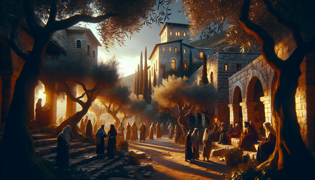
The Journey into Shadows
In the days that followed, as the village awoke to the gentle luminescence of the early sun, Khalil’s resolve grew stronger. The morning mist clung delicately to the olive groves, imbuing the landscape with an almost sacred quality. With a heart buoyed by both trepidation and determination, he decided to venture beyond the familiar, his eyes set on uncovering the truth shrouded in the ghoul’s legend. Gathering a small pack of essentials—water, a modest loaf of freshly baked flatbread, and a hand-carved talisman passed down through his lineage—Khalil stepped quietly along the winding, earthen paths that led to the edge of the village.
As he moved deeper into the groves, the natural beauty of the land revealed itself in full. Olive trees, gnarled and majestic, stood like silent sentinels guarding the realm of myth and memory. Sunlight filtered through the intricate canopy, creating a pattern of light and shadow that danced upon the ground. The air was thick with the aroma of earth and green leaves intermingled with a hint of wild thyme. Every rustle of the disturbed foliage and every whisper of the wind carried with it the echoes of the past—a story too compelling to ignore.
Khalil’s solitary journey was both physical and spiritual. At times, the deep, vibrant hues of the landscape made him feel as if he were stepping into a living tapestry of nature’s most vivid colors, while at other moments, the solemn quiet provoked questions that humbled his youthful spirit. There were moments of doubt when the memories of fearful whispers from the village threatened to cloud his rational mind. Yet, with each step, he affirmed his belief: that understanding the unknown required not blind acceptance of inherited terror, but a brave encounter built upon respectful inquiry and compassion.
His path led him to a crumbling stone structure half-swallowed by creeping vines—a relic, perhaps, of lost times. The architecture, with its ancient arches and worn inscriptions, whispered of indulgences and secrets of bygone eras. Here, the faint remnants of past gatherings and forgotten rituals seemed to pulse with a subtle, soft light, as if inviting him to unravel the mysteries held within its walls. Khalil’s fingers traced the delicate carvings, his eyes absorbing every nuance of history etched into the stone. In that quiet moment, the oppressive labels of ‘monster’ began to dissolve. The ghoulish lore that had terrorized his peers subtly transformed into a narrative of warning—a testament against the perils of unfounded bias and the need for truthful understanding.
In this suspended reality, where nature and history conspired with destiny, Khalil silently vowed to honor the legacy of his people by seeking the truth, not for glory or fear, but for the sake of unity and healing. His solitary journey was a courageous act of defiance against ingrained superstition—a pilgrimage into the core of his community’s collective heart to reclaim authenticity from the shadows of myth.
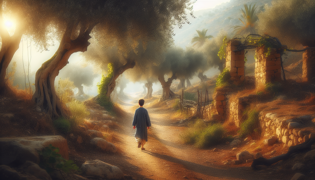
The Face of the Ghoul
As Khalil ventured further into the realm of ancient stones and whispering groves, an unexpected encounter awaited him. The day burgeoned with an intense, almost otherworldly brightness as he reached a secluded clearing. There, seated near a gently murmuring spring, was a figure whose presence belied the monstrous image embedded in local lore. Unlike the terrifying silhouette recounted by the elders, this entity bore the marks of sorrow and longing. Draped in garments that echoed the textures of fading history—tattered yet dignified— the being’s eyes shimmered with a quiet luminescence, reflective of a lifetime of misunderstood isolation.
Khalil’s heart pounded with an unsteady rhythm. His initial instinct was to recoil from what his imagination had always painted as a hideous visage, yet he felt an overwhelming compassion that stilled his steps. In the silence that followed, their eyes met—an exchange where fear was quietly supplanted by a shared vulnerability. The creature’s gaze, heavy with past regrets and the burden of centuries-old legends, silently pleaded for an understanding that defied the simplistic labels of ‘ghoul’ or ‘monster.’
In a tentative dialogue woven not of words but of empathetic glances and measured gestures, Khalil began to decipher the stories that had long defined his community’s relationship with the unknown. The being, whose quiet dignity resonated with the sorrow of the oppressed, seemed less an embodiment of evil and more a mirror reflecting the community’s own deep-seated biases. Over time, as minutes stretched and the light of the day softened into a gentle embrace, the creature extended an unspoken invitation—a call for an honest exploration of pain, prejudice, and the possibility of redemption.
Questions crowded Khalil’s mind; Was the ghoul’s supposed malevolence merely a byproduct of misinterpretation? Could the fear and bias of his community have distorted the truth into something monstrous? As he sat attentively, the creature’s silent narrative unraveled a tapestry of lost memories and misunderstood gestures. It was a confession phrased in the language of remorse—a testament to isolation born from the fear of difference. The encounter challenged the very foundation of the legends that had both defined and divided the village for generations.
In that resonant clearing, bathed in the honest light of day, Khalil’s perspective began to realign. The ghoul was not the embodiment of evil that superstition had insisted it be, but rather a victim of collective bias—a scapegoat for the real and often unspoken fears that lay within the hearts of many. With courage tempered by empathy, he promised the silent figure that he would carry this newfound understanding back to his people, hoping to transform a narrative of fear into one of unity and compassion.
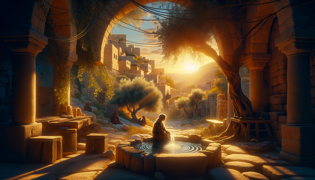
The Breaking of Chains
Emboldened by the intimate encounter and the quiet truths it had revealed, Khalil prepared to return to his village with a mission to reshape the narrative that had for so long chained his community to outdated biases. The journey back was not merely a physical retracing of steps, but a pilgrimage of heart and mind—a deliberate effort to reframe the ghoul’s story in terms of empathy and redemption.
As he re-entered the familiar winding lanes of the village, bathed in the resplendent glow of a late afternoon sun, Khalil felt as though the world itself had subtly shifted. Even the simple everyday rhythms—a mother calling her children from the loom of her day’s work or an elder tending to a modest garden—seemed imbued with an unexplained anticipation. The air carried both the warmth of community and the faint aroma of spiced coffee and baked bread, each element weaving together a tapestry of shared existence.
Without delay, Khalil sought out the village elders, the very custodians of the legends and fears that had so long divided them. In the modest setting of a communal courtyard, where the textures of stone and the soft hues of twilight intertwined with the villagers’ heartfelt murmurings, he began to unravel the narrative. With measured calm and unwavering sincerity, he recounted his journey—the hesitant steps into the depths of the olive groves, the silent exchange of glances with a being burdened by misunderstood sorrow, and the profound realization that the true horror lay not in the creature, but in the bias that had been allowed to flourish without question.
The reaction was a mixture of astonishment, discomfort, and cautious hope. Some villagers found their long-held beliefs unsettled by Khalil’s revelations; others were visibly moved, their eyes reflecting a dawning recognition of how fear could transmute into prejudice. As the dialogue deepened, heartfelt voices emerged, drawing connections between personal experiences of isolation and the damaging effects of labeling anything that deviated from the norm as monstrous. This new narrative was not about negating the past, but about forging a path forward that embraced understanding above fear.
Under the fading light of the day and in the gentle embrace of community, a silent pact was formed. The elders, parents, and even the most timid souls promised to view future legends with the discerning eye of empathy. In place of simple horror, they now saw a call to introspection—a reminder to question inherited biases. Khalil, with the purity of his conviction and the deep reassurance of authenticity, had not only dismantled a myth but also kindled a transformative movement. His journey symbolized the breaking of chains that had long bound fear and prejudice, inviting the village to replace outdated narratives with hope, dialogue, and unity.
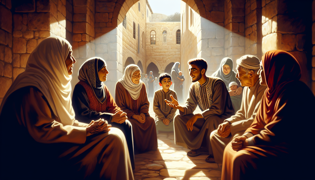
Conclusion
In the quiet aftermath of a day that altered the pulse of community history, the village began to slowly awaken to a new dawn—one defined by the courage to question, the heart to empathize, and the will to transform. Khalil’s journey, steeped in quiet valor and reflective compassion, had sown the seeds of a shift that transcended the boundaries of myth and fear. The ghoul, once a specter of terror, emerged as a poignant emblem of the cost of prejudice—its distorted image a mirror held against the villagers’ own capacity for bias. In sharing his truth, Khalil had not only challenged the ancient legends but had also invited his people to embrace a spirit of open inquiry and collective healing.
Within the warm embrace of his community, the transformation was subtle yet profound. Conversations once halted by fear now blossomed with the language of reflection and understanding. Elders, survivors of outdated tales, acknowledged that their fears had inadvertently clouded the beauty of authentic connection. As nights gave way to brighter mornings, the village learned a timeless lesson: that courage is found not in the absence of fear, but in the willingness to face it and transmute it into compassion.
The transformation was not instantaneous. There were quiet moments of hesitation and deep-rooted traditions that clung to the past like shadows in the bright light of the new day. However, the dialogue that Khalil initiated rippled through time, creating spaces where empathy replaced estrangement and where every whispered legend was met with a discerning, compassionate heart. In this small corner of Palestine, the brave heart of a young boy had redefined what it meant to be a guardian of tradition—reminding all that true strength lies in the willingness to challenge bias and in the realization that sometimes the scariest monsters are those we create within ourselves. And as the village embraced its newfound unity, a gentle, enduring hope shone forth, lighting a path toward a future where differences were celebrated and every soul was seen with the clarity of truth.

















